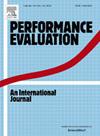随机环境下漏桶的量规
IF 0.8
4区 计算机科学
Q4 COMPUTER SCIENCE, HARDWARE & ARCHITECTURE
引用次数: 0
摘要
泄漏桶通常用于网络接入控制,其中接入控制代表网络入口处的流量调节。在网络微积分中,泄漏桶是指定网络输入边界的片断线性到达曲线背后的模型,通常用于网络的性能分析或尺寸确定。在本文中,我们利用流体队列分析了随机到达情况下基于漏斗的访问控制,此时访问控制可能由多个漏斗实现。这就产生了针对不同随机到达过程(包括相关到达)的访问控制参数维度的方法。这种方法是弥合使用队列网络的经典随机分析与使用网络微积分的确定性分析之间差距的一步。文中介绍了使用数值方法对随机到达过程进行分析的结果,以及使用轨迹驱动模拟对测量到达过程进行分析的结果。本文章由计算机程序翻译,如有差异,请以英文原文为准。
Dimensioning leaky buckets in stochastic environments
Leaky buckets are commonly used for access control in networks, where access control stands for traffic regulation at the ingress of the network. In network calculus, which is often applied for performance analysis or dimensioning of networks, leaky buckets are the model behind piecewise linear arrival curves that specify an input bound to a network. In this paper we present the analysis of leaky bucket based access control under stochastic arrivals using fluid queues, when the access control is implemented by possibly more than one leaky buckets. This results in methods to dimension parameters of access control for different stochastic arrival processes including correlated arrivals. The approach is one step to bridge the gap between classical stochastic analysis using queuing networks and deterministic analysis using network calculus. Results are presented for stochastic arrival processes using numerical methods and for measured arrivals using trace driven simulation.
求助全文
通过发布文献求助,成功后即可免费获取论文全文。
去求助
来源期刊

Performance Evaluation
工程技术-计算机:理论方法
CiteScore
3.10
自引率
0.00%
发文量
20
审稿时长
24 days
期刊介绍:
Performance Evaluation functions as a leading journal in the area of modeling, measurement, and evaluation of performance aspects of computing and communication systems. As such, it aims to present a balanced and complete view of the entire Performance Evaluation profession. Hence, the journal is interested in papers that focus on one or more of the following dimensions:
-Define new performance evaluation tools, including measurement and monitoring tools as well as modeling and analytic techniques
-Provide new insights into the performance of computing and communication systems
-Introduce new application areas where performance evaluation tools can play an important role and creative new uses for performance evaluation tools.
More specifically, common application areas of interest include the performance of:
-Resource allocation and control methods and algorithms (e.g. routing and flow control in networks, bandwidth allocation, processor scheduling, memory management)
-System architecture, design and implementation
-Cognitive radio
-VANETs
-Social networks and media
-Energy efficient ICT
-Energy harvesting
-Data centers
-Data centric networks
-System reliability
-System tuning and capacity planning
-Wireless and sensor networks
-Autonomic and self-organizing systems
-Embedded systems
-Network science
 求助内容:
求助内容: 应助结果提醒方式:
应助结果提醒方式:


